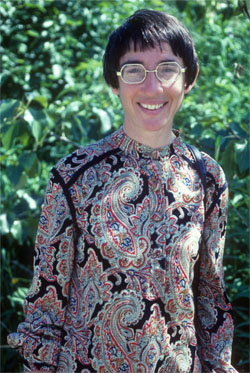Pamela Roe Graduate Student Endowed Fund
By Rachel Anderson
This past spring a group of Pam Roe’s dear friends and colleagues joined together to honor her by establishing the Pamela Roe Graduate Student Endowed Fund at FHL. Pam’s dear friend and fellow FHL student, Rita O’Clair, led the charge and boy did she do an incredible job of soliciting funds! All the while, everyone involved shared wonderful memories about their times with Pam!
The Pamela Roe Graduate Student Endowed Fund will benefit graduate students participating in courses and/or conducting research at the Friday Harbor Laboratories. Preference will be given to students in the fields of marine invertebrate zoology (including embryology and parasitology) or marine biology, with a strong emphasis on natural history or ecology. To honor Pam’s long tenure at California State University Stanislaus (CSU Stan), students from that institution will also be given special considerations.
Fundraising efforts continue strong with hopes to meet the endowment funding goal by 2016.
To honor Pamela Roe by contributing to this important scholarship fund, please contact: Rachel Anderson at rachelea@uw.edu, or make a gift online. Thank you!
Pamela Roe
By Rita O’Clair

Photo credit: Rita O'Clair
Although Pamela Roe was born in San Angelo in west central Texas, she was raised in Corpus Christi on Texas’ gulf coast, where she had her first exposure to marine life. She did her undergraduate degree in zoology at the University of Texas, Austin, and entered the graduate program at the University of Washington in Seattle in 1965, eager to learn more. Her master’s degree (1967) and doctorate (1971) were awarded for her work under Prof. Alan J. Kohn. She focused on the natural history and the feeding and reproductive biology of Paranemertes peregrina, the Purple Ribbon Worm, and did most of her field work at the Friday Harbor Laboratories. While at UW, Pam was noted for her generosity towards other graduate students, always willing to share supplies, help with field work, and give advice to newer students.
With her new doctorate fresh in hand, Pam was immediately hired to teach at California State University Stanislaus (CSUStan) in Turlock, about 27 miles southeast of Modesto in California’s agricultural Central Valley. She absolutely loved her job and devoted all of her time to it. She remained there for 40 years, teaching invertebrate zoology, marine biology and general parasitology to a wide variety of students—many were minorities and some had never seen an ocean. Like most biologists, Pam cherished diversity and had great empathy for her minority students. She was well known for her terrific sense of humor, and due to her tiny stature she was frequently mistaken for a student herself. Field trips to the California coast, 2 1/2 hours away by car, were de rigeur. Taking advantage of the CSUStan’s term structure of 4+1+4, Pam often used the month of January to take students down to Jamaica or Belize to introduce them to both marine and terrestrial tropical biology. In other years she used the January mini-term to offer a research course focused on Wood Duck behavior in the Central Valley.
Pam also continued her research on ribbon worms (nemerteans), and was active in the American Society of Zoologists and Western Society of Naturalists, among other professional societies. She did much of her nemertean research with Dr. Jon Norenburg of the Smithsonian Institution, including some fascinating observations of deep-sea pelagic species, and together they co-chaired the First International Symposium on Nemertean Biology in 1983, under the auspices of the American Society of Zoologists, and then the 4th such conference in 1985, at Asilomar in Pacific Grove, California. Pam was recognized both for her teaching and her research. She was named the Outstanding Professor of CSUStan for the 2000-2001 academic year, and in 2007 was awarded the President’s Medal at CSUStan for her excellent services to that university over four decades. In 2001 she was enormously proud when she received the Naturalist of the Year award from the Western Society of Naturalists.
Tragically, Pam’s career was cut short by several years due to the ravages of early-onset Alzheimer’s disease.



